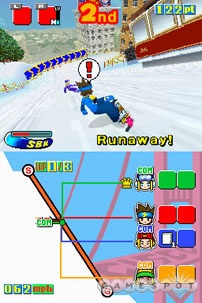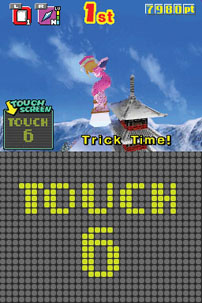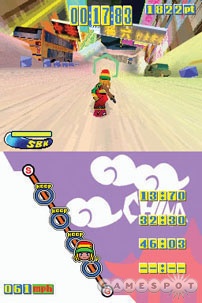If you took a traditional snowboarding game--SSX, for example--and crossed it with Mario Kart in some sort of Frankenstein experiment, you'd end up with something like SBK: Snowboard Kids. The teenybopper characters in Atlus' snow-themed racing game compete on downhill courses and perform tricks just like the characters in any run-of-the-mill snowboarding game would, but they also have the added benefit of being able to harass one another with weapons and items while out on the slopes. This unique marriage of genres succeeds for the most part, despite a minimalist selection of tricks and the fact that some shots and items are nearly impossible to defend against. If anything, the game's biggest shortfall is that the single-player experience is exhausted rather quickly.

Players can take control of any of nine different teen phenoms, each with their own abilities, boards, and trick sets, and set out on any of seven courses in various race and trick competitions. Fans of the two Nintendo 64 Snowboard Kids games will recognize the cast in the DS game, as well as a few of the items, but not much else, as the courses in the sequel are entirely new and the organizational structure of the play options is more straightforward than it was in the N64 games. Gone is the 3D village where players could choose events, talk to other characters, and uncover new locations. The social aspects and wandering that gave the N64 games an extra dash of personality were left out of the DS game in favor of a portable-friendly menu structure that spells out matter-of-factly what events and options are available. Solo play modes include world tour, slalom, and boss battle. The world tour mode is the most involved, as it offers three different tournaments that present all of the game's courses with a variety of score and ranking goals. Points earned in all modes can be used to unlock the small handful of characters, boards, costumes, and courses that aren't initially available. There's also a multiplayer Wi-Fi mode, which allows as many as four players to compete using one or multiple game cards.
Out on the slopes, the game plays like a mixture of SSX and Mario Kart. As is true of any traditional snowboarding game, you ultimately want to end up in first place or at the top of the point standings, depending on what the event calls for. However, besides controlling the board and performing tricks, you and the other racers can also harass each other with item pickups and magical shots. Items can be picked up by running through the boxes that are strewn around the course. Meanwhile, each kid has the ability to shoot magical shots that automatically home in on nearby targets. The basic controls are similar to any other snowboarding game, with steering and tricks made possible by pressing directions on the D pad and holding the different buttons in midair. Generally speaking, it's easier to perform tricks in the DS game than it was in the two N64 games because fewer button inputs are necessary. In a controversial move, Atlus made it so that signature tricks are performed by tapping hot spots on the touch screen. That's sure to annoy people who are averse to the touch screen, but, on the upside, there's never any fumbling with the stylus, because the hot spots are large enough to tap with a finger. The game also makes limited use of the microphone, requiring players to blow into the microphone in order to shake off status effects such as sleep and blindness.

Some aspects of the game are more fleshed out than others. Even though there aren't that many of them, the courses are lengthy and interesting. Most have optional shortcuts. The variety of item pickups is also good. There's the usual assortment of speed boosters and land mines, as well as a few clever creations, such as the parachute, which slows victims down, or the fog bomb, which temporarily blinds its victims. Compared to other snowboarding games, and even the two previous Snowboard Kids games, the trick system in this game is rather simplistic. Grinding on rails is impossible, and only a handful of tricks can be chained together at any given opportunity. As it is, there really aren't all that many unique tricks to perform. Most characters only have two unique flips, spins, and grabs in their repertoire, which can be performed separately or in combination, as well as a pair of signature tricks.
In the grand scheme of things, the lack of tricks isn't such a big deal, even in light of the fact that there are fewer tricks in the DS game than either of the N64 games, because the game is more focused on racing than the performance of trick routines. More problematic than the dearth of tricks is the unfair CPU. All three CPU boarders have a habit of ganging up on the human player. They also regenerate their magic quicker. Neither of these biases would be so bad alone, but together they are often annoying, especially since there's no way to reflect magic shots while on the ground. For reasons only known to the game's designers, magic shots can only be reflected in midair by performing spin tricks.
Everything that the single-player mode has to offer can be completed and unlocked in around four hours. After that, your mileage will obviously vary based upon how much you still enjoy the game once there aren't any more concrete goals to strive for. When Atlus produced the two Snowboard Kids games for the Nintendo 64, they provided players with an added incentive to play through the game with each character, in the form of multiple dialogue scenes and endings sequences. They didn't do that with the DS game, apart from a couple brief lines of dialogue bookending every tournament and a single illustrated frame that appears when you beat the last tournament with each character.
If your friends own DS systems, you can significantly extend the game's lasting value by taking advantage of its single-card and multicard local Wi-Fi features. Using a single copy of the game, as many as four players can duke it out on the Alps trick course. Multicard play allows full access to every course and event in the game, and lets players toggle items and weapons on or off. Multiplayer is more fun than solo play, for obvious reasons, not the least of which is that human players are less likely to gang up on any one particular person. Apart from a few hiccups that happen when the joined DS systems are located too far apart from one another, multiplayer play is just as smooth as solo play.

Anyone who can appreciate things that are young at heart will enjoy the game's presentation. The large menu icons, cute character portraits and models, and colorful course features come together to make SBK feel warm and inviting. So too, the peppy music selections and enthusiastic character voice clips contribute to the game's upbeat atmosphere. The musical compositions aren't as intricate or melodic as those we've heard in other DS racing games, but they are catchy and do fit the overall tone of the game. Players familiar with the N64's Snowboard Kids games will recognize the cast of characters. The majority of the old cast is back, though they've aged into teenagers since their last outing. From a technical standpoint, the game doesn't flaunt the system's graphical capabilities, but the polygonal scenery is adequately detailed and there's a good sense of speed throughout. It helps that the frame rate is silky smooth, as are the various character- and trick-related animations. The system also doesn't have a problem displaying every part of the course up ahead, with the exception of laid traps such as land mines and ice walls. With regard to the course itself, the draw distance is ample. For some reason, however, traps often pop into view barely a few steps in front of the characters.
All told, SBK: Snowboard Kids should provide a fair amount of enjoyment to those who warm up to its unique design. This blending of snowboarding and Mario Kart-style racing isn't for everyone, and some aspects certainly could have been implemented better; but on the whole, the game is fun and interesting.